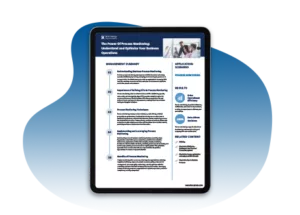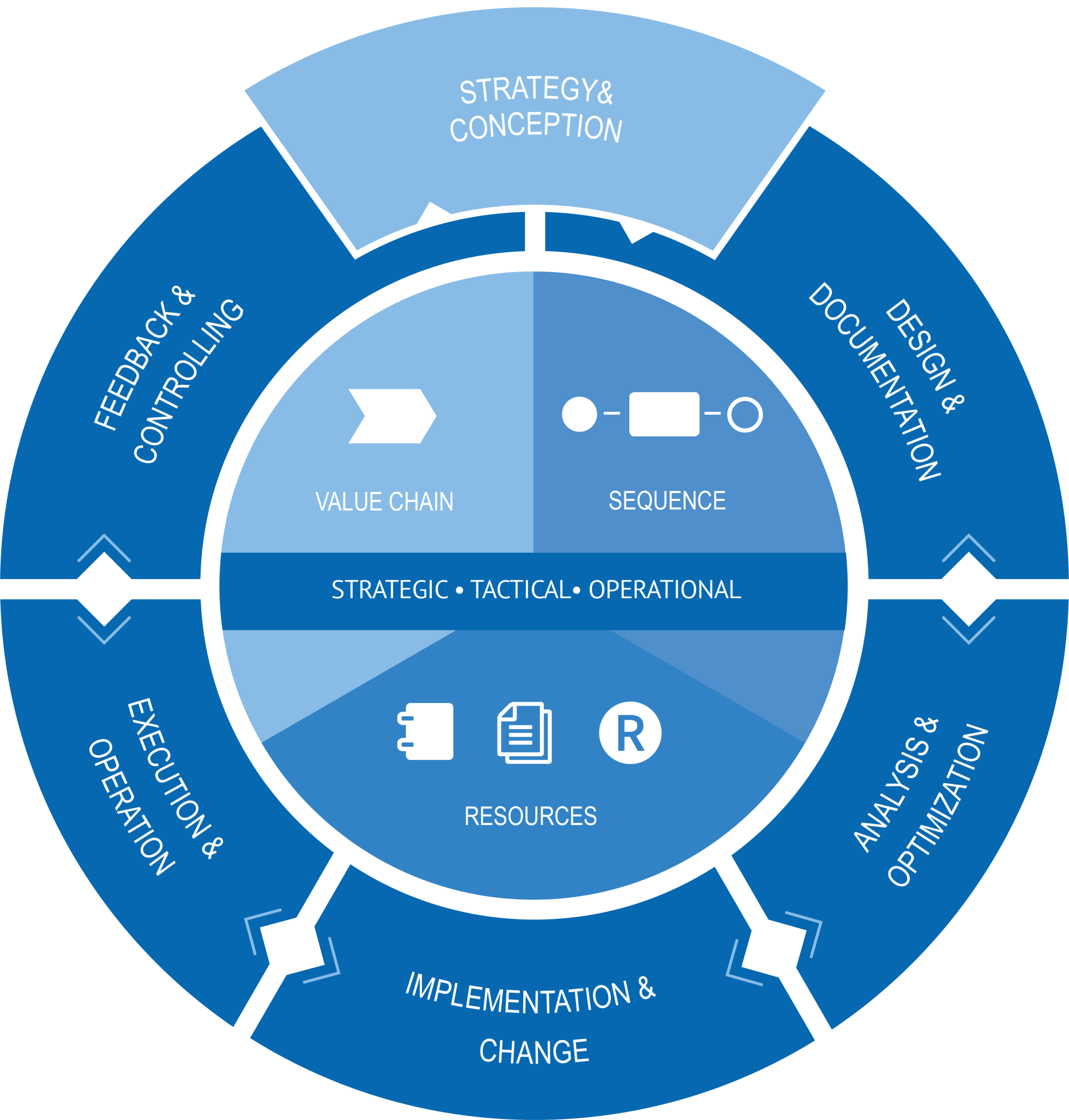Found this helpful? Share it with peers.
Introduction
Business Process Management (BPM) is a widely-used and effective management approach that aims to transform organizational operations using holistic and structured methods and technologies. With a central focus on efficiency and effectiveness, BPM simplifies processes, lowers costs, and boosts customer satisfaction to help organizations achieve their objectives.
This blog post explores the fundamentals of BPM, its stakeholders, and how implementing Business Process Management Systems can benefit your company.

Want a short digest of our blog’s main ideas?
Download summary!
What is Business Process Management (BPM)?
Business Process Management (BPM) is a well-established and widely used management discipline that focuses on managing and transforming business processes, holistically and within defined, structured methods and technologies. These methods and tools are used to analyse, design, implement, monitor and continuously improve business processes. BPM focuses on identifying and eliminating inefficiencies and process redundancies to improve performance, reduce costs, and increase customer satisfaction.
What is the purpose of business process management?
The purpose of business process management (BPM) is to systematically analyze, model, optimize, and improve the processes within an organization. BPM aims to enhance efficiency, productivity, and agility by streamlining workflows, eliminating bottlenecks, reducing errors, and ensuring that business processes align with organizational goals and objectives. Ultimately, BPM helps organizations achieve operational excellence, adapt to changes in the business environment, and deliver value to customers and stakeholders.
Differentiating Between BPM and BPM Software
Business Process Management (BPM) is a discipline used by organizations to identify, document, and improve their business processes. It involves analyzing workflows, identifying inefficiencies, and implementing changes to optimize operations.
On the other hand, Business Process Management Software (BPMS) is the technology that enables BPM. It provides tools and platforms for organizations to map out processes, automate tasks, monitor performance, and make data-driven decisions to enhance efficiency and agility.
While BPM focuses on managing and optimizing business processes, BPMS is the software infrastructure that facilitates the execution of BPM practices through automation, analytics, and process monitoring.
In summary, BPM is the methodology, while BPMS is the technology that supports and enables the implementation of BPM principles within an organization.
What Is Business Process Management Software?
Business Process Management Software (BPMS) is a technology solution designed to support and streamline Business Process Management (BPM) initiatives within organizations. BPMS provides tools and capabilities to define, model, automate, monitor, and optimize business processes. This software enables businesses to improve efficiency, agility, and productivity by digitizing and automating workflows, reducing manual effort, eliminating errors, and ensuring compliance with organizational policies and industry regulations. Utilizing BPMS, businesses can gain insights into their processes, identify bottlenecks, and continuously improve operations to achieve strategic objectives.
Why engage in Business Process Management (BPM)?
Organizations use Business Process Management to successfully address various challenges arising from external and internal factors. According to researchers1, there are two different drivers for BPM – business and IT. On one side, coming from the strategic aspect, are business trends such as globalization, dynamic markets, rapid information transfer, global standards, interorganizational value chains, rapid decision making, and outsourcing; and on the other, emerging from the IT perspective, are flexible IT architectures, mobile IT, and new communication tools.
What are the benefits of Business Process Management (BPM)?
BPM offers numerous advantages to businesses. Some of those benefits include:
Increased productivity and efficiency
By automating and streamlining workflows, companies can eliminate bottlenecks, and reduce the time and effort required to complete tasks. This in turn leads to improved productivity and efficiency.
Increased quality of results
BPM helps standardize all processes in an organization. Standardizing work and ensuring compliance, if done properly, leads to higher and better quality of results.
Increased customer satisfaction
By understanding a process and identifying areas where it could be made more customer-friendly, organizations can increase customer satisfaction and improve their reputation.
Cost and waste reduction
BPM helps companies identify and eliminate inefficiencies and redundancies in their processes. This results in lower operating costs and higher profitability.
Improved multi-experience
BPM helps companies understand their customers’ needs and provide them with a more personalized experience. The same approach also helps build relationships internally with employees, increasing their satisfaction and thus productivity. By identifying and fixing issues, companies can improve the overall satisfaction of their stakeholders.
Increased flexibility and agility
BPM enables companies to quickly adapt to changing market conditions and customer demands. By being able to change processes quickly and efficiently, companies can be more flexible and agile in responding to new opportunities and challenges.
Improved collaboration and communication
BPM helps break down silos and improve communication and collaboration between different departments and stakeholders. By providing a unified view of processes and real-time collaboration, BPM can help organizations achieve their goals more effectively and efficiently.
Tipp: Check out how other companies perceive BPM from our 2024 trends study.
Reduced Errors
By standardizing processes and introducing automated controls, BPM minimizes the occurrence of errors and improves the overall quality of outputs
Improved Visibility
BPM provides comprehensive visibility into various business processes, allowing managers to monitor performance, identify bottlenecks, and make data-driven decisions
Customer Satisfaction
By streamlining processes and improving efficiency, BPM enables organizations to deliver better products and services, leading to increased customer satisfaction and loyalty
Strategic Alignment
BPM ensures that business processes are aligned with strategic goals, enabling organizations to focus on activities that drive growth and innovation
Implementing Business Process Management (BPM)
Successful implementation of BPM in organizations requires collaboration among all stakeholders, including management, employees, and customers. It requires a commitment to continuous improvement and a willingness to adapt and change to achieve business goals.
As defined above, Business Process Management is a systematic approach to achieving business goals, and there are several key steps to consider when implementing it in an organization:
Process Definition
Identifying processes that need to be managed and their inputs, activities and outputs.
Process Analysis
Identifying processes that need to be managed and their inputs, activities and outputs.
Process Optimization
Redesigning processes based on the analysis to achieve better efficiency and effectiveness.
Process Implementation
Communicating changes to all stakeholders, providing training on the new processes, and ensuring that all stakeholders understand their roles and responsibilities.
Process Execution
Performing the actual work.
Process Monitoring
Controlling and observing the execution of processes and evaluating performance.

What are common BPM methods
Looking at BPM from a higher-level perspective, it’s a fairly intuitive management approach – you standardize the way your organization gets things done, share the preferred way of doing things with all stakeholders, and make sure that your work flows in the way you want it to. This all however does require a deeper dive into the subject. There are many different BPM methodologies, and we recommend that you do your research to find the most suitable one for your organization.
The diversity of methods in Business Process Management results from the different levels of BPM adoption in a company. According to the Handbook on Business Process Management, methods such as Six Sigma and Lean Management cover the entire business process lifecycle, but are not as rich as the methods that support enterprise-wide BPM adoption.
Six Sigma
The Six Sigma approach to quality management can be part of a more holistic BPM. Applied within a BPM framework, Six Sigma provides a structured approach to identifying and prioritizing areas for improvement, establishing measurable goals, and monitoring progress toward those goals. By integrating Six Sigma with BPM, companies can streamline processes, reduce waste and improve overall efficiency. What’s more, Six Sigma can help companies align their business processes with the needs of their customers, thereby increasing customer satisfaction and loyalty. Therefore, Six Sigma is an effective process improvement tool when used as part of a larger BPM approach.
Lean Management
Lean Management is a methodology that can be integrated with Business Process Management to optimize value streams and eliminate waste. By identifying and eliminating non-value adding activities, such as overproduction and waiting, organizations can create lean processes that are more efficient and cost-effective. Lean Management emphasizes employee engagement in process improvement, which can improve work morale and create a culture of continuous improvement. By integrating Lean Management into BPM, companies can improve process efficiency, reduce costs, and improve the overall customer experience.
Other BPM methods
Furthermore, there are a number of other methods that can be used within a broader Business Process Management framework to improve process performance, including:
- Total Quality Management (TQM): A holistic approach to process improvement that emphasizes the importance of quality at all levels of the organization.
- Agile: An iterative approach to software development that emphasizes collaboration, flexibility, and rapid response to changing customer requirements.
- Design Thinking: A customer-centric approach to problem solving that emphasizes empathy, ideation, and experimentation.
- Kaizen: A Japanese term meaning “continuous improvement.” It involves the gradual and continuous improvement of processes, with an emphasis on small, incremental changes.
- Business Process Reengineering (BPR): A radical approach to process improvement that involves the complete redesign of business processes.
- Plan-Do-Check-Act (PDCA): A four-step, iterative approach to process improvement that includes planning a process, implementing it, reviewing the results, and taking action to improve it.
These methods can be used in any order and in combination with others to create a comprehensive BPM framework, tailored to the unique needs and challenges of each organization. One of the more comprehensive approaches that combines the above methods is Process Management Lifecycle.
Process Management Lifecycle
The Process Management Life Cycle (PMLC) is a cyclical procedure model for Process Management and supports companies in increasing their business success through Business Process Management.
The PMLC consists of six phases:
- Strategic Business Process Management
- Process Design and Documentation
- Process Analysis and Optimization
- Process Implementation & Change Management
- Process Execution & Operation
- Process Controlling & Feedback
Each phase builds upon the previous one and provides the necessary foundation for the subsequent phase to be effective. Therefore, it is important to recognize the critical role that each phase plays in the PMLC and give equal attention and importance to all of them.

BOC Group’s Process Management Lifecycle (PMLC)
The Process Management Lifecycle (PMLC) method has width, depth, and flexibility, and can be used on strategic, tactical, or operational levels. PMLC covers the entire process portfolio, allowing organizations to gain a comprehensive understanding of how value is created, optimized, and delivered to customers.
Value chains illustrate the holistic nature of BPM, where each activity, task, and process works together to maximize value. PMLC can be applied to single processes or the entire portfolio. Depending on the maturity of Process Management, PMLC can be started at any phase and phases can be skipped, allowing organizations to be agile in implementing process management and organization.
New technologies can help discover process data and automate processes, which PMLC can support in an iterative way. The iterative approach is essential in continuously improving processes over time by identifying potential issues and areas for optimization at each stage. This helps organizations to be more adaptive and responsive to changes and continuously boost their operational efficiency and effectiveness. It further ensures that BPM delivers value to the organization and its stakeholders.
Stakeholders involved in Business Process Management
BPM is not just for process managers or IT professionals; it involves everyone from the C-level executives to the worker on the factory floor who reads working procedures. By working together, stakeholders can identify process improvement opportunities, implement changes, and monitor the results to ensure that the process is running efficiently and effectively. When employing the PMLC approach to BPM, roles and responsibilities of the stakeholders may vary based on the phase.
These are the most important BPM stakeholders and their roles:
Process managers
Responsible for the day-to-day operation of the process, ensuring that it runs smoothly and meets its objectives.
Process owners
Responsible for managing the end-to-end process and ensuring that it is running efficiently
Subject matter experts
Individuals who contribute information to the processes, using their practical knowledge to expand on the documentation of the organizational processes.
Business analysts
Work closely with process managers and process owners to identify process improvement opportunities and develop action plans.
Readers
Those who read the process documentation, including working procedures and policies. They may be employees who need to understand the process they are working with, or auditors who are reviewing the organization’s processes for compliance.
Auditors (both internal and external)
Internal auditors are responsible for ensuring that the organization’s processes are compliant with internal policies and procedures, while external auditors ensure that the organization is complying with relevant regulations and standards.
Regulators
Play a crucial role in ensuring that business processes adhere to legal and industry standards, providing oversight and guidance on compliance matters.
Change managers
Responsible for facilitating the smooth transition of process changes within an organization, ensuring proper communication, training, and adoption strategies are in place.
Quality managers
Focus on maintaining and improving the quality of processes, products, and services, implementing measures to meet or exceed customer expectations.
Compliance managers
Responsible for ensuring that business processes adhere to relevant regulations, standards, and internal policies, mitigating risks associated with non-compliance.
Risk managers
Identify, assess, and mitigate risks associated with business processes, ensuring that potential threats are managed effectively to safeguard organizational objectives.
Enterprise architects
Design and oversee the structure and integration of business processes within an organization’s overall architecture, ensuring alignment with strategic goals and IT infrastructure.
Summary
Business Process Management (BPM) is a management approach focused on analysing, designing, implementing, monitoring, and improving business processes to transform organizational operations holistically. It can increase productivity, improve quality outcomes, enhance customer satisfaction, improve collaboration, increase flexibility and agility, and reduce costs.
In order to implement BPM successfully, all parties involved must work together. The introduction of a tool such as our industry-acclaimed BPM suite ADONIS can support this even better. It allows companies to exploit the full potential of BPM and join forces across the enterprise.







